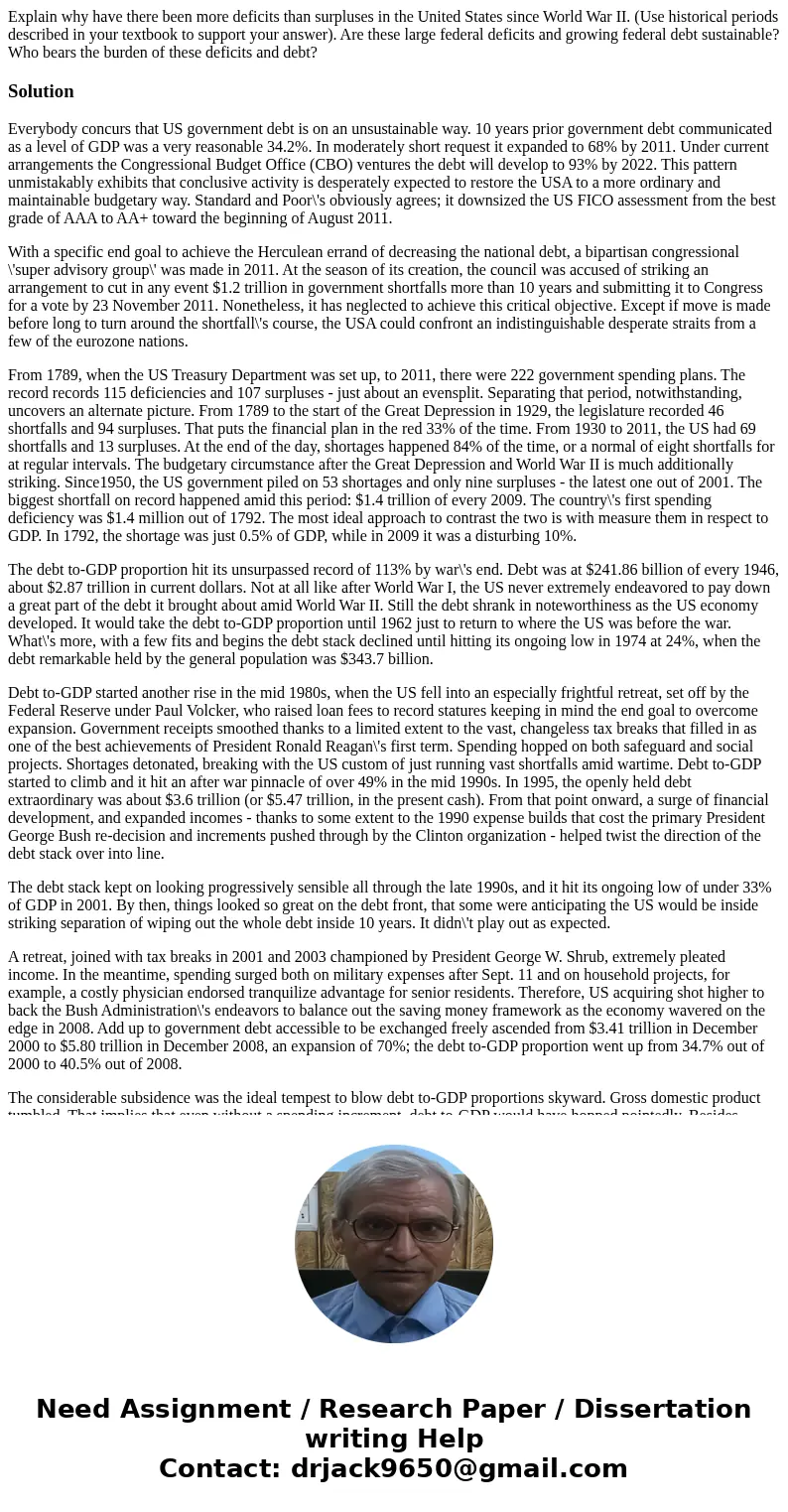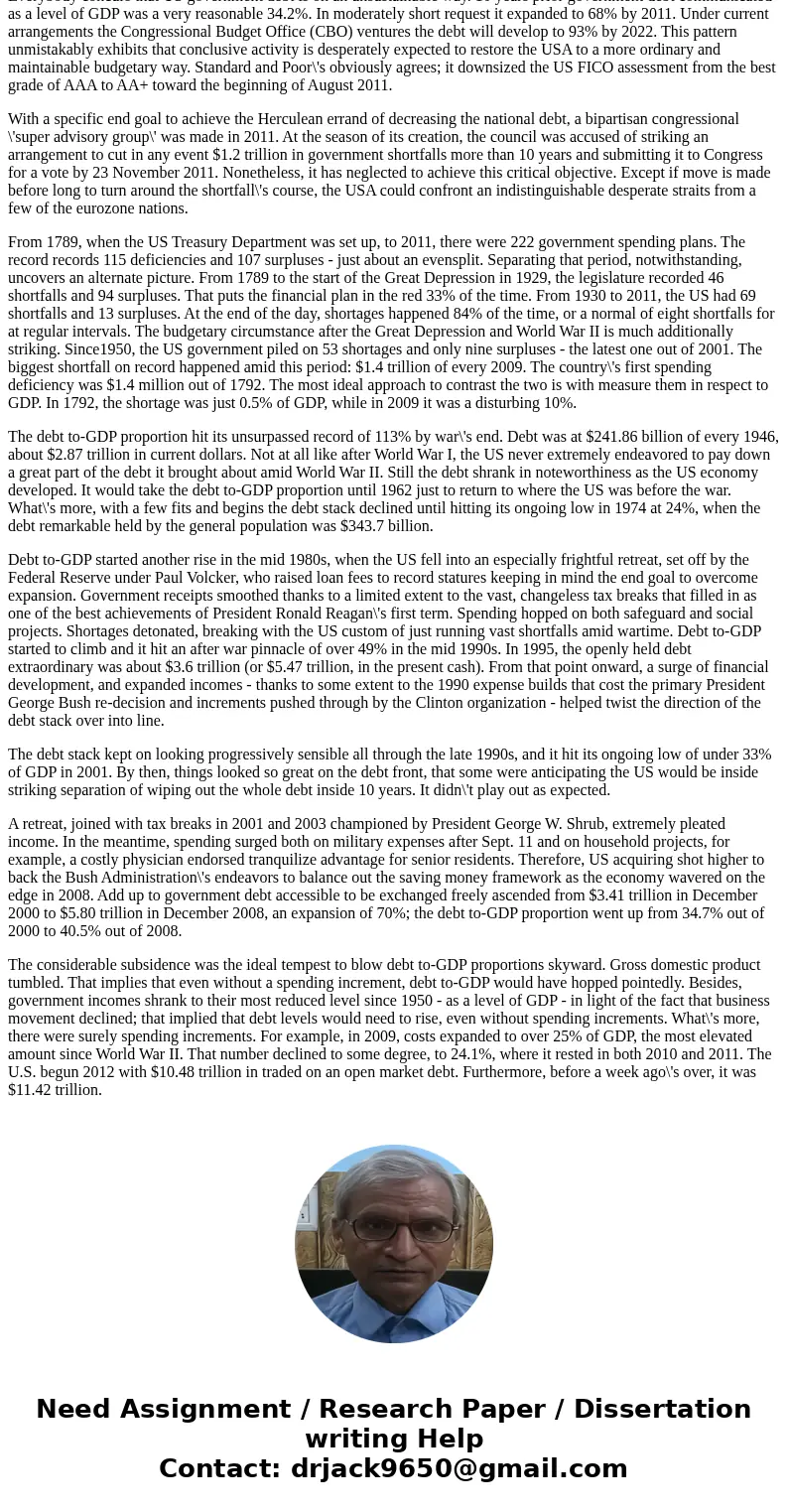Explain why have there been more deficits than surpluses in
Explain why have there been more deficits than surpluses in the United States since World War II. (Use historical periods described in your textbook to support your answer). Are these large federal deficits and growing federal debt sustainable? Who bears the burden of these deficits and debt?
Solution
Everybody concurs that US government debt is on an unsustainable way. 10 years prior government debt communicated as a level of GDP was a very reasonable 34.2%. In moderately short request it expanded to 68% by 2011. Under current arrangements the Congressional Budget Office (CBO) ventures the debt will develop to 93% by 2022. This pattern unmistakably exhibits that conclusive activity is desperately expected to restore the USA to a more ordinary and maintainable budgetary way. Standard and Poor\'s obviously agrees; it downsized the US FICO assessment from the best grade of AAA to AA+ toward the beginning of August 2011.
With a specific end goal to achieve the Herculean errand of decreasing the national debt, a bipartisan congressional \'super advisory group\' was made in 2011. At the season of its creation, the council was accused of striking an arrangement to cut in any event $1.2 trillion in government shortfalls more than 10 years and submitting it to Congress for a vote by 23 November 2011. Nonetheless, it has neglected to achieve this critical objective. Except if move is made before long to turn around the shortfall\'s course, the USA could confront an indistinguishable desperate straits from a few of the eurozone nations.
From 1789, when the US Treasury Department was set up, to 2011, there were 222 government spending plans. The record records 115 deficiencies and 107 surpluses - just about an evensplit. Separating that period, notwithstanding, uncovers an alternate picture. From 1789 to the start of the Great Depression in 1929, the legislature recorded 46 shortfalls and 94 surpluses. That puts the financial plan in the red 33% of the time. From 1930 to 2011, the US had 69 shortfalls and 13 surpluses. At the end of the day, shortages happened 84% of the time, or a normal of eight shortfalls for at regular intervals. The budgetary circumstance after the Great Depression and World War II is much additionally striking. Since1950, the US government piled on 53 shortages and only nine surpluses - the latest one out of 2001. The biggest shortfall on record happened amid this period: $1.4 trillion of every 2009. The country\'s first spending deficiency was $1.4 million out of 1792. The most ideal approach to contrast the two is with measure them in respect to GDP. In 1792, the shortage was just 0.5% of GDP, while in 2009 it was a disturbing 10%.
The debt to-GDP proportion hit its unsurpassed record of 113% by war\'s end. Debt was at $241.86 billion of every 1946, about $2.87 trillion in current dollars. Not at all like after World War I, the US never extremely endeavored to pay down a great part of the debt it brought about amid World War II. Still the debt shrank in noteworthiness as the US economy developed. It would take the debt to-GDP proportion until 1962 just to return to where the US was before the war. What\'s more, with a few fits and begins the debt stack declined until hitting its ongoing low in 1974 at 24%, when the debt remarkable held by the general population was $343.7 billion.
Debt to-GDP started another rise in the mid 1980s, when the US fell into an especially frightful retreat, set off by the Federal Reserve under Paul Volcker, who raised loan fees to record statures keeping in mind the end goal to overcome expansion. Government receipts smoothed thanks to a limited extent to the vast, changeless tax breaks that filled in as one of the best achievements of President Ronald Reagan\'s first term. Spending hopped on both safeguard and social projects. Shortages detonated, breaking with the US custom of just running vast shortfalls amid wartime. Debt to-GDP started to climb and it hit an after war pinnacle of over 49% in the mid 1990s. In 1995, the openly held debt extraordinary was about $3.6 trillion (or $5.47 trillion, in the present cash). From that point onward, a surge of financial development, and expanded incomes - thanks to some extent to the 1990 expense builds that cost the primary President George Bush re-decision and increments pushed through by the Clinton organization - helped twist the direction of the debt stack over into line.
The debt stack kept on looking progressively sensible all through the late 1990s, and it hit its ongoing low of under 33% of GDP in 2001. By then, things looked so great on the debt front, that some were anticipating the US would be inside striking separation of wiping out the whole debt inside 10 years. It didn\'t play out as expected.
A retreat, joined with tax breaks in 2001 and 2003 championed by President George W. Shrub, extremely pleated income. In the meantime, spending surged both on military expenses after Sept. 11 and on household projects, for example, a costly physician endorsed tranquilize advantage for senior residents. Therefore, US acquiring shot higher to back the Bush Administration\'s endeavors to balance out the saving money framework as the economy wavered on the edge in 2008. Add up to government debt accessible to be exchanged freely ascended from $3.41 trillion in December 2000 to $5.80 trillion in December 2008, an expansion of 70%; the debt to-GDP proportion went up from 34.7% out of 2000 to 40.5% out of 2008.
The considerable subsidence was the ideal tempest to blow debt to-GDP proportions skyward. Gross domestic product tumbled. That implies that even without a spending increment, debt to-GDP would have hopped pointedly. Besides, government incomes shrank to their most reduced level since 1950 - as a level of GDP - in light of the fact that business movement declined; that implied that debt levels would need to rise, even without spending increments. What\'s more, there were surely spending increments. For example, in 2009, costs expanded to over 25% of GDP, the most elevated amount since World War II. That number declined to some degree, to 24.1%, where it rested in both 2010 and 2011. The U.S. begun 2012 with $10.48 trillion in traded on an open market debt. Furthermore, before a week ago\'s over, it was $11.42 trillion.


 Homework Sourse
Homework Sourse